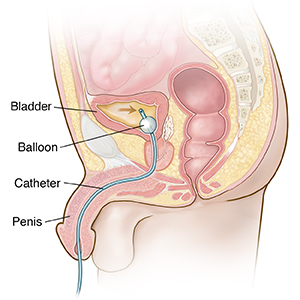Urinary Retention (Male)
Urinary retention means you can't empty all the urine from your bladder. You may have trouble urinating. In some cases, you may not be able to pass any urine at all. This condition happens even though your bladder is full.
We understand gender is a spectrum. We may use gendered terms to talk about anatomy and health risk. Please use this information in a way that works best for you and your doctor as you talk about your care.
Causes
The most common cause of urinary retention in men is the bladder outlet being blocked. This can be due to an enlarged prostate gland or an infection in the prostate (prostatitis) or bladder (urinary tract infection). This condition is more likely to occur as men get older.
Certain medicines, including some for blood pressure, can also cause this problem.
Symptoms
Acute urinary retention happens suddenly and will cause symptoms. Chronic urinary retention comes on slowly and may cause few or no symptoms. Common symptoms of urinary retention include:
-
Pain or discomfort in your lower abdomen (not everyone has this).
-
Frequent urination in small amounts.
-
Feeling that the bladder is still full after urinating and a desire to urinate again.
-
Difficulty starting the flow of urine (hesitancy)
-
Not being able to control the release of urine or leakage of urine without any warning or urge (incontinence).
-
An urgent need to urinate, but with little success.
-
Swollen belly (abdomen).
Treatment
Acute retention of urine is typically treated by putting a tube (catheter) into the bladder to drain the urine. It gives relief right away. The catheter may need to stay in place for a few days. The catheter has a balloon on the tip. This is inflated after the catheter is put in the bladder. It prevents the catheter from falling out.

Your doctor may prescribe medicines to treat the condition causing your urinary retention. If your previous medicines were causing it, your doctor may lower the dose use a different medicine, or stop the medicine.
If other treatments don’t work, your doctor might suggest surgery. One example is removing part of the prostate.
Home care
-
If your doctor prescribed antibiotics, take them as directed. Do not stop taking them just because you feel better. You need to take the full course of antibiotics.
-
If a catheter was left in place, it's important to keep bacteria from getting into the collection bag. Follow your doctor's advice about how to care for the catheter and the skin around it. Don't disconnect the catheter from the collection bag.
-
Use a leg band to secure the drainage tube, so it doesn't pull on the catheter. Drain the collection bag when it's full using the drain spout at the bottom of the bag.
-
Don't pull on or try to take out your catheter. This will harm your urethra. The catheter must be removed by a doctor.
-
Do not stop taking your medicines without first talking with your doctor.
-
Don't take any over-the-counter medicines for allergies, colds, aches, and fever without asking your doctor. Some of these medicines may make your urinary retention worse.
-
Do Kegel or pelvic muscle strengthening exercises, as shown by your doctor or physical therapist.
-
Keep your bowel movements regular to prevent constipation. Try increasing the fiber in your diet.
-
Try timed voiding. This means urinating at set times to prevent your bladder from becoming too full. Your doctor may recommend a schedule to help you train your bladder.
-
Try double voiding This means waiting a short time after you urinate to try and go again. This will help to make sure that your bladder is completely empty after you urinate.
-
Don't be in a rush to urinate or overstrain your bladder. Take extra time in the bathroom. Sit on the toilet seat and don't hover over it. This will help to relax your muscles and empty the bladder as much as possible.
Follow-up care
Follow up with your doctor, or as advised.
If a catheter was left in place, it can often be removed in 3 to 7 days. Some conditions need the catheter to stay in longer. Your doctor will tell you when to come back to have it removed.
When to contact your doctor
Contact your doctor right away if:
-
You have a fever of 100.4ºF (38ºC) or higher, or as directed by your doctor.
-
You feel bladder or lower-belly pain or fullness.
-
You have belly swelling, nausea, vomiting, or back pain.
-
There's blood or urine leaking around the catheter.
-
Bloody urine is coming from the catheter (if a new symptom).
-
If a catheter was left in place and it falls out or has stopped draining for 6 hours.
Call 911 if:
-
You feel weak, dizzy, or faint.
-
You feel sudden weakness, numbness, or tingling in an arm or leg.
-
You feel confused or less alert.
Online Medical Reviewer:
Melinda Murray Ratini DO
Online Medical Reviewer:
Raymond Kent Turley BSN MSN RN
Online Medical Reviewer:
Vinita Wadhawan Researcher
Date Last Reviewed:
5/1/2025
© 2000-2025 The StayWell Company, LLC. All rights reserved. This information is not intended as a substitute for professional medical care. Always follow your healthcare professional's instructions.